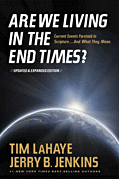BOOK REVIEW: Are We Living in the End Times?
Are We Living in the End Times? by Tim LaHaye and Jerry B. Jenkins is a comparatively light and readable introduction to “typical” End Times exegesis, if by “typical” one understands the Protestant, fundamentalist, and pre-millennial approach. At 370 pages it might appear lengthy, but the material is not at all dense, and is vastly more condensed than the thousands of pages these same authors have produced in their fictionalized version of the same theme, the (in)famous Left Behind series of novels and movies.
While differing in emphasis and detail from other writers on this topic, the general content runs along similar lines. The authors claim that literal interpretation of the Bible provides a vast amount of prophecy about the End of the World, and that time is almost up. There will be a Rapture, in which true believers will be taken into heaven to avoid the horrors of the Tribulation. The seven years of Tribulation will include plagues, wars, meteors striking the earth, massive earthquakes, supernatural stinging insects, and other horrors. An Antichrist will unify a beleaguered world and impose the Mark of the Beast on all who want to engage in commerce. World powers will almost destroy themselves at the battle of Armageddon, but Jesus will intervene, bind the devil and his minions, and rule the world for a thousand years of nearly perfect order. At the end of the Millennium there will be one final paroxysm of rebellion before the entire physical universe is wiped out of existence and remade in godly perfection. Unbelievers, of course, will burn in Hell for all eternity.
Explaining End Times prophecy is only one part of the authors’ intent. They repeatedly invite the reader to convert, on one page even offering the words to use in prayer. They also hope their readers will take this kind of conversion viral, encouraging them to “greater efforts in evangelism,” and to become “more missionary minded.” These ideas are often presented after a particularly harrowing description of God’s wrath, which will strike the skeptical reader as fear-mongering, the adult equivalent of telling the kiddies that “the boogieman will get them” if they don’t behave.
Readers looking for hard argumentation as to why one ought to believe this particular form of biblical interpretation, or even an admission that most Christians think otherwise, will be disappointed. The authors clearly saw their audience as Protestant Christians already disposed to fear divine judgment and to interpret scripture in a literal sort of way. Where arguments are raised, they address only one particular interpretation of End Times prophecy versus another, not the validity of End Times theory in general.
There is a moderate amount of background theology presented here, and this is the book’s most serious failing. The authors presume that their audience knows little of world history, political systems, or comparative religion. Their factual errors are egregious, and more educated readers can only find the authors’ attempts in these areas ridiculous. This damages any credibility a more open minded secularist, or any other informed reader, might try to give to the book.
It is shocking, indeed, to learn that “long before the word for it had been coined, socialism had been a Babylonian philosophy for the conduct of government, commerce, and religion” (132), that “Babylon is where Satan located his headquarters.” “Every false religion in the world can be traced back to Babylon,” we are told, and that Satan himself introduced there the “foundational teachings for Hinduism, Buddhism, Taoism, Gaia worship and a host of other cultic systems . . . ” (172). Even after the Crucifixion and Resurrection, “the pagan practices and teachings of Babylon began to worm their way into Christianity. These included prayers for the dead, making the sign of the cross, worship of saints and angels, instituting the mass, and worship of Mary” (173). And never to miss a dig at anything secular or scientific, LaHaye and Jenkins write, “the theory of uniformitarianism, popularized in the mid-1800s by the English geologist Sir Charles Lyell, became a prominent foundation for Darwinism and evolution, Marxism and socialism, Freudianism and liberalism. It fostered many of the evils that beset our society today and is propagated by the most intellectually trained members of our society” (348). In fact, a great deal is revealed about the fundamentalist opposition to evolution in particular, and to science in general, when the authors write, “if you eliminate the biblical worldwide flood, as uniformitarians do, you remove a vital proof for the second coming of Christ. But if in fact there was a flood, then God really does judge sinful men, and there is good reason to believe He will come again to judge the world. If man accepts the reality of the Flood, he is pressed to accept the likelihood of Christ’s second coming” (349). That is as succinct a summary of Creationist motivations as I’ve ever read.
It is easy to dismiss Are We Living in the End Times? as superstition by and for the unschooled. But the secular-minded ought not lose sight of the social phenomenon represented here. LaHaye and Jenkins have been tremendously successful with their books and movies, as have other self-styled prophets and prophet-interpreters. They reach millions. And let us not underestimate the mystical appeal of examining world events from within their frame of reference. Israel came back into existence in 1948. In 1967 Israeli forces took control of Old Jerusalem, supposedly bringing the reconstruction of the Jewish Temple one step closer. Before his execution Saddam Hussein devoted significant Iraqi funds to the reconstruction of the ruins of Babylon. To a certain kind of Christian these are all powerful symbols, echoes of ancient visions, indicators of the approach of the end of the history.
– Jim Dugan

